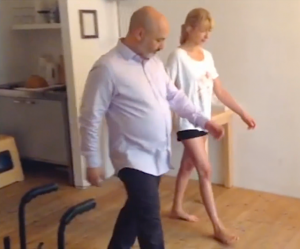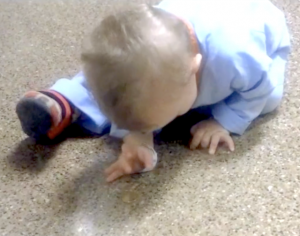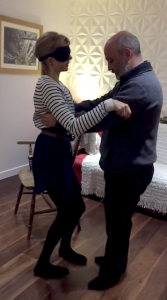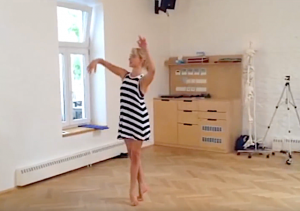 Dr. Joaquin Farias, a leading specialist in treating dystonia, has been helping people with this debilitating movement disorder to recover control over their brains, bodies and lives for more than 20 years. As a featured speaker at the 2018 international conference on Movement: Brain, Body and Cognition, held July 27-29 at Harvard University School of Medicine, he gave an enlightening talk that shed new insight into our understanding and treatment of dystonia. He also offered fresh hope by highlighting an alternative, self-driven treatment path through which patients might become asymptomatic, redefining surviving and thriving with dystonia.
Dr. Joaquin Farias, a leading specialist in treating dystonia, has been helping people with this debilitating movement disorder to recover control over their brains, bodies and lives for more than 20 years. As a featured speaker at the 2018 international conference on Movement: Brain, Body and Cognition, held July 27-29 at Harvard University School of Medicine, he gave an enlightening talk that shed new insight into our understanding and treatment of dystonia. He also offered fresh hope by highlighting an alternative, self-driven treatment path through which patients might become asymptomatic, redefining surviving and thriving with dystonia.
The Dystonia Medical Research Foundation currently defines dystonia as a movement disorder, “characterized by persistent or intermittent muscle contractions causing abnormal, often repetitive, movements, postures or both.” These are hypothesized to result from hyperactivity in different parts of the brain, such as the cerebellum and sensory cortex. In his Harvard presentation, Farias offered a new conceptualization of the condition as a dysregulation of the nervous system, characterized by miscommunication between the neural cells that initially results in diminished muscle activity, or hypoactivity, for which the body then overcompensates with hyperactivity of muscles. Farias redefined dystonia as a “functional disconnection disorder.”
Farias likened the dystonia patient to a surfer trying to ride an uncontrollable wave. “You are trying to ride a wave, but you are falling, and you have no control over the condition that Is controlling your own body,” he said. “You can imagine how distressing is this experience, where you…send a signal to a part of your body, but it’s not responding as you expected.” He urged clinicians treating dystonia patients to “be in the wave with them,” rather than attempt to observe and treat them only from an outsider perspective. He posited that a patient cannot be diagnosed without knowing “the aim of [their] movement and also what he is perceiving and how the body is interacting with the environment.”
Medical professionals typically concentrate on the hypercontraction–extreme shortening and tightening of the muscles–or hypertonus–an excess of uncontrollable spasms–of patients with dystonia. Using the example of his young patient Jesús, Farias pointed out how clinicians would tend to focus on the hyperactivity of the hip flexor and knee extensor muscles of the young boy’s right side, which caused an abnormal gait that was captured on video. On closer examination, it was revealed that Jesús had hypoactivity of the left side of his body. According to Farias, the boy’s neurological system had impaired communication with his left leg, so he was systematically avoiding flexion of his left hip, while his left knee exhibited a tremor-like indecision over whether to flex or extend. Thus, Farias said, Jesús was compensating for the instability of his left leg by overstepping with the right.
 Additionally, the child expressed involuntary movement in the arms and head. Farias observed that there was similar over-priming of Jesús’s right eye, as a resulted of limited function of the left eye. Like me, the boy’s left eye was failing to properly communicate with the brain, so the right eye was doing all the work of seeing. Other clinicians who saw Jesús assumed he was seeing equally from both his eyes, but Farias observed the child trying to take a coin from the floor solely using input from his right eye. Jesús was contracting the sternocleidomastoid muscle along the right side of his neck, to turn his head and bring his dominant eye closer the floor.
Additionally, the child expressed involuntary movement in the arms and head. Farias observed that there was similar over-priming of Jesús’s right eye, as a resulted of limited function of the left eye. Like me, the boy’s left eye was failing to properly communicate with the brain, so the right eye was doing all the work of seeing. Other clinicians who saw Jesús assumed he was seeing equally from both his eyes, but Farias observed the child trying to take a coin from the floor solely using input from his right eye. Jesús was contracting the sternocleidomastoid muscle along the right side of his neck, to turn his head and bring his dominant eye closer the floor.
While his movements were “off target,” due to limited depth perception, they were “not so involuntary” and were an efficient way to deal with “a failure in the function,” said Farias. “So, it looks that the condition starts in the hypo-function…and then, the hyper-function looks to be a form of decompensation at the neural level.”
Through his work with patients as director of the Neuroplastic Training Institute Toronto and as researcher at the University of Toronto, Farias observed that “when you’re stimulating the area that is hypo-functioning, the area that is hyper-functioning takes care of itself; it’s going to normalize.” He said that this occurs through the process of neuromodulation, which is a physiological process that alters the activity of the nervous system through targeted stimulation. In his conference talk, Farias suggested that patients can become asymptomatic with training on neuromodulation.
Traditionally, there have been three main lines of medical treatment for people with dystonia: injection of botulism neurotoxin into specific muscles to relax them and to reduce excessive muscle contractions; drug intervention through oral medications to help manage symptoms; and Deep Brain Stimulation (DBS), which, as the name implies, artificially stimulate the deep brain through a surgically implanted, battery-powered “brain pacemaker,” in an effort to suppress the excessive signaling from the brain, which is generally thought to cause the involuntary muscle contractions and movements of dystonia. These treatments have varying degrees of ‘success’ at effectively managing symptoms for patients–what may work for one patient may not work for another patient, and what works now may not work a year or two from now. Without continual administration of each of these treatments, it is common for the patient to revert back to debilitating movement and impaired function.
Neuromodulation, on the other hand, is a natural process of the body that is self-generated and, thus, puts the patient back into the driver’s seat, if you will, of his or her own recovery. “So, neuromodulation is not a technique that the doctor learns and applies on a patient,” Farias explained. “Neuromodulation is a function of the nervous system, so we need to encourage patients to use this function and develop it.”
In Jesús’s case, he was able to regain proper movement by training his focus on also moving his hypoactive left hip and knee. “So, it’s actually when he is stepping, he is saying ‘go to the right’ and then saying ‘go, go the left,’” Farias said. The boy was also given specific exercises to do for three minutes, twice a day, to stimulate the left eye, while covering the right eye. A video of Jesús years later showed him smoothly walking up and down the street like a typical, school-aged boy.
Farias guides patients, like Jesus, in retraining the brain to restore proper cognitive and motor functions. Tapping into the neuroplasticity of the brain–its astounding capacity to rewire itself, self-repair and heal–Farias designed a revolutionary, ‘do-it-yourself’ program, which helps patients with these neurological disorders to reawaken dormant neural pathways, to uncover and dismantle learned and “unconscious defense patterns” behind the muscle spasms and tremors of the body, and “to bring movements, emotions, sensations back to life.” In his lecture, Farias noted, “It’s interesting because, in the past, we considered that plasticity was only possible in the cortex, but now we can see that we can induce plasticity in the deep brain.”
The mind-blowing effects of his signature Neuroplastic Movement Therapy were further elucidated at the conference through Farias’s case study of Susan Birchwood. The woman was a 16-year-old training professionally as a dancer when she developed the first symptoms of dystonia. What began as cramps in the hand spread to a generalized dystonia, with abnormal muscular activity throughout her body. Laryngeal spasms made her choke, and spinal spasms could fold and flatten her like an omelet. Suffering what Farias dubbed a “neurological blackout,” Birchwood was no longer able to move her right leg, and she ended up in a wheelchair.
Birchwood was unable to walk for almost 20 years, but that changed dramatically after her training sessions with Farias. Beechwood took the first step in The Farias Technique by re-engaging with her former passion of dancing, which served as her ‘lifeline’ in the recovery process. She started exploring movement by first dancing in the wheelchair. Forced movement and rhythm had “the very unexpected outcome” of allowing her to feel her right leg again.
“The first reconnection that [someone with dystonia needs] to do is reconnecting with society, reconnecting with the environment, reconnecting with your life–the life that you have before the day of onset of the condition,” Farias said.
While a therapist can provide information and help facilitate and guide the neuroplasticity training, the patient ultimately must take the actions to “change their own brain” and to do the work to treat and heal themselves. He said, “So I always say that the first thing the patient needs to do is to react; you need to react and take care of yourself.”
 The next of “the three main disconnections of dystonia” that needs to be addressed is inter-hemispheric disassociation. Here, one half of the brain is not properly communicating with the other half of the brain, as was clearly exhibited by Jesús. This can cause very particular symptoms like nystagmus (repetitive, involuntary, to-and-fro eye movements), double vision and walking difficulties. In Birchwood’s case, one side of the body was hypertonic, while the other was hypotonic, Farias said. He had her work with a mask on to help bridge the gap.
The next of “the three main disconnections of dystonia” that needs to be addressed is inter-hemispheric disassociation. Here, one half of the brain is not properly communicating with the other half of the brain, as was clearly exhibited by Jesús. This can cause very particular symptoms like nystagmus (repetitive, involuntary, to-and-fro eye movements), double vision and walking difficulties. In Birchwood’s case, one side of the body was hypertonic, while the other was hypotonic, Farias said. He had her work with a mask on to help bridge the gap.
“Most of my clients, when they close their eyes, they can move way better,” he said. Practicing with a mask or in the dark can be a great starting point for patients because the brain with dystonia is “extremely noisy, and at the same time, it is not able to make proper sense of the input,” he said, “so reducing the activity in the visual cortex helps reduce the load of tasks that the brain is developing.”
Once the two hemispheres of the brain were reconnected in Birchwood, Farias could “switch off” the asymmetrical tonic reflex in her leg and awaken the dormant, neural pathways by stimulating other parts of her body. “And this is the third step of rehabilitation; that is when we do the neuromodulation,” he said.
“Once that I was able to switch off the primitive reflex, we could start doing the re-education of the movement. So the patient started to do a re-tuning of the cerebellum and the vestibular system,” he said.
Birchwood had to relearn to walk after 18 years in a wheelchair; astonishingly, she was able to do it in four days. “So that was something that was surprising…and told me something–it looks that, in dystonia, there is no brain damage,” Farias said. “It looks that the brain remembers. It looks that everything is there, is in place; you just need to access it. And in order to access it, you just need to provide the proper pathway for the brain to connect with the memory.”
After eight hours of training guided by Farias, Birchwood had worked up to walking 20 steps at a time. Then, something totally unexpected happen. She began to dance–something she hadn’t done in two decades. Farias believes that the artistic movement was her “safe line–rescuing the memory, reconnecting the brain…and giving back the ability and the essence” of her intact and whole self.
https://youtu.be/-8f_A16OwSo?t=15m57s
 Farias believes the woman’s return to dance created a massive ripple effect throughout her body, which helped to resolve the third and final disconnection of dystonia. He calls this “the top-to-bottom/bottom-to-top disconnection,” in which there is dysautonomia, a systemic malfunction of the Autonomic Nervous System, which governs the functions of the body that occur without our conscious thought, such as heart rate, blood pressure, digestion and temperature control. Additionally, there may be hyperactivity of the sympathetic nervous system, which governs the fight or flight response.
Farias believes the woman’s return to dance created a massive ripple effect throughout her body, which helped to resolve the third and final disconnection of dystonia. He calls this “the top-to-bottom/bottom-to-top disconnection,” in which there is dysautonomia, a systemic malfunction of the Autonomic Nervous System, which governs the functions of the body that occur without our conscious thought, such as heart rate, blood pressure, digestion and temperature control. Additionally, there may be hyperactivity of the sympathetic nervous system, which governs the fight or flight response.
When the fight-or-flight response is continually activated, the body ‘freezes’ as it perceives even everyday stressors as signs of danger. The resulting, chronic state of elevated physiological stress leads to poor digestion, shallow breathing, insomnia, fatigue, inflammation and increased susceptibility to infection. It’s no wonder then, that dystonia patients frequently suffer from a host of additional health problems.
“It’s extremely common that [people with dystonia] have thyroid dysregulation, adrenal dysregulation, and they develop autoimmune conditions,” Farias said.
He also revealed that Birchwood had been struggling with getting and sustaining pregnancy before training with him. He believes this was a result of dysautonomia. After the woman regained her ability to walk and dance, she was able to conceive and birth a healthy boy.
“So this is essential because it’s letting us know that also movement re-education/movement rehabilitation is also affecting the other symptoms of dystonia, including this dystautonomia,” Farias said. “So, in helping a person to walk, [you also might be] helping a person to get pregnant.”
Birchwood’s comprehensive recovery is an inspiring example for dystonia patients, like me, who continue to strive for top-to-bottom healing. Her and Jesús’s stories help to consolidate all the seemingly random puzzle pieces of ill health that can accompany the diagnosis of dystonia. Knowing that we can learn to “become really good swimmers” in its turbulent waters, believing that there are action steps we can take to push the most debilitating symptoms from the crest of the wave to the bottom of the ocean, casts a brilliant beacon of hope as we carve our arms and legs into waters in pursuit of passionate, purposeful and fulfilling lives.
Dear Dr Farias,
I hope this mesage finds you well. I have just heard about you throug a closed net Fb-group for people that have dystonia. One Finnish lady told she has almost recovered from the illness. Another has recently Bennington your consultation. One is going next month.
I just wonder if you are expert also in my kind of case. I was diagnosed ordimandibular dystonia in December 2013. In the beginning speaking was a little bit difficult and there were many good long periods when it was easier. Specially after one successful acupuncture trestment, 12-13 times, once a week. Also when I was travelling.
Afterwords, it become difficult to eat, I lost weight. I get Botox every 3-4 month and the first month always even makes it more difficult to speak. And also destroys if I have managed to speak before that because of the acupuncture or Voice massage. Those treatments I don’t get anymore. I do, if I pay myself, but it’s pretty expensive. I work on public sector with little salary as a Cultural Producer. For my work I would need speaking naturally. And have now difficulties with my boss.
I also started to get pains in my neck. And after a year, my head started to go down. Now with force. It’s painful to walk, bicycle, go to gym etc, which I try still. The tension and pressure is very heavy and strong in the neck-throut area.
I’m so afraid that one day I will loose my work as everything is becoming so difficult for me. I need a very good chair to give support to my back and neck. Also when metrinen friends etc. we have to find s place that I can sit steadily. Otherwise I get’s too painful for me.
But i’m afraid that in this way, my neck become even more ”lazy”.
Same thing when I get Botox in the muscles that turn the head. I cannot get my head up from the pillow fir the first month.
Now, do you think you could help me? Do you have experience in these kind of dystonia?
I understood you are from Canada and come time to time to Europe. Never to Finland?
I’m looking eagerly forward for your reply and
hope one day I could speak again and get rid of my pains that are caused by my head going down.
If you do have any instructions for me, I would be more than greatful.
Hi Arja, this article was written about Dr. Farias’s lecture, but I have no formal affiliation with the doctor. You can contact him directly here.
After you mentioned this doctor and his work, I remembered that when I was learning to walk as a child, I tried to stand and walk upright without going through the crawling stage–and I kept falling on my head so my mother made a helmet for me. Today that story is a little bit of a running joke with those who know me and my personality–I’m usually one to run head first into things and then get bumped around. Given my health condition today, which is some form of dysautonomia, I found it interesting that he proposes that this condition is a “disregulation of the nervous system’. I wonder if his approach can be adapted to other conditions. Also after reading this article in which he mentions blindfolding patients to minimize external visual input, I realized that I close my eyes often when trying to communicate something difficult (emotionally, conceptually, technically). Also when I was grappling doing JuJitsu. Just some thoughts. Very interesting and I will keep an eye on what this doctor is doing.
Hey Melissa, Not surprisingly, I too ran into things constantly as a child. Your array of symptoms would definitely fit under the umbrella of dysautonomia. And I too tend to close my eyes during emotional discussions…and sometimes, while running.
So, Dr. Farias’s approach offers a refreshing way to look at these kinds of disorders/disregulations–his lecture gave me a lot of hope for further managing dystonia actually.
So, I have tried blindfolding during yoga, and it’s such an amazing way to retrain the brain–especially working on balance and motor control in standing poses, for me. I’d highly recommend experimenting with.
I’m hoping to get in to see Dr. Farias before too long. I will definitely share what I learn and experience there with you!
Hi 2 years ago I all of the sudden couldn’t stop my head from going down and forward really hard from morning until night when I finally past out from exoustion and after the first year of that I tried Botox injections and soon after my head wants to go down and to the right really hard like after a while I would start to get the pain in my neck I found out I had cirvicle destonia or not had I still have it my dad told me what it was you see my dad had this for 12 years before he found a doctor who new what it was and he got the deep batterie implant he suggests that I should try to get the surgery as well but after seeing your lecture on the internet I felt like there might be hope for me if I can learn how to use the muscles that my brain forgot how to use that makes more sense to me than getting Botox injections that are just going to paralize the neck even more and if I’m like my dad I will be amune to it anyway one nuroligist I have seen gave me carbadopa levadopa at first I took this pill and I was finally able to get some sleep without so much spasms but my head still does the same thing after hearing you speak I go to work doing a very physical job and practice every day how to walk and work and keep my head from turning on its own I have come a long way now I can hold conversations with people and walk around a store in public without feeling embarrassed it is still there though when I’m driving turning the station on the radio or when I’m at home looking at the phone texting like I am now my head jerks alot so I keep practicing texting walking driving trying to do all this without putting my hand to my face and it’s one hell of a fight I can see improvement I just wanted to know if you had any suggestions for me as far as exorcise I can do at the gym I love lifting weights and use to be in teakwondo I want to stay strong I’m hoping it all helps me but I’m not an expert and so far this is a hell of thing fighting my own brain . thank you I’m really glad you are out there helping people like me I didn’t want to give up but sometimes when you have something like this you want to cut your own head off or burry your head in the sand but I’m not giving up thank you.